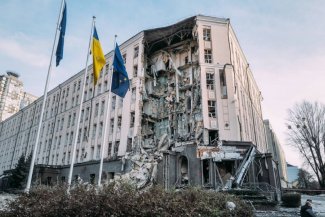Announcements of new military equipment for Ukraine. Day 315 of the war

The main area of clashes remains Bakhmut and the towns south and northeast of it. Street fighting continues in Soledar. Ukrainian defenders have apparently repelled further assaults along the Bakhmut-Siversk railway line, in the vicinity of Avdiivka and west of Donetsk. Russian forces also renewed their attacks on the border between the Luhansk, Kharkiv and Donetsk oblasts. Ukraine attempted a counterattack south of Huliaipole in the Zaporizhzhia oblast.
The Russians continued to strike at Ukrainian army positions and resources along the contact lines and in the border areas. Rockets fell on Zaporizhzhia and Kramatorsk, as well as on Druzhkivka and Kostiantynivka which lie south of Kramatorsk. Kherson and Nikopol, together with surrounding towns, remain under constant fire, as does the Ochakiv area. Acts of Ukrainian sabotage were reported in occupied Melitopol and Sevastopol, as well as on Russian territory: in Kursk, Rostov-on-Don and Novy Oskol in the Belgorod oblast, from where a fire in an ammunition depot was reported.
France intends to provide Kyiv with an unspecified number of AMX-10 RC armoured reconnaissance vehicles (as these are armed with 105-mm cannons, they are referred to as wheeled tanks) and 20 ACMAT Bastion armoured personnel carriers; no date of delivery was specified. The new US military support package is to include additional HIMARS launchers. Washington is also apparently considering providing Ukraine with M2 Bradley infantry fighting vehicles. Norway has provided Kyiv with a further 10,000 155-mm calibre artillery shells.
Serhiy Deyneko Head of the State Border Service of Ukraine said that there are between 10,200 and 10,500 enemy troops on the territory of Belarus, mainly in the Vitebsk oblast. Russia is said to be planning to redeploy some of its troops from Belarus to the Donbas in the coming weeks and to send soldiers from the 6th Mechanised Division of the 3rd Army Corps (AC) in their place. Deyneko said that he considers it unlikely that Belarusian territory will be used for another offensive against Ukraine due to the small number of forces gathered there.
On 3 January, Ukraine’s prime minister Denys Shmyhal announced that after the war ends, Ukraine should build an army based fully on contract service, and all citizens should be given the opportunity to acquire military knowledge and skills. As he put it, the army is moving towards NATO standards directly on the battlefield, as it is following Western principles of strategic planning, education, personnel & unit training and warfare. He stressed that the government intends to strengthen public security infrastructure, by means including expanding the network of modern air raid shelters and equipping educational institutions, hospitals, residential & public buildings and critical infrastructure facilities with appropriate protection. In view of the threat of sabotage, gated metal detectors and baggage scanners will be installed in selected public places.
The head of Ukrainian military intelligence, Kyrylo Budanov, announced on 4 January that Kyiv was planning a spring offensive in the area from Crimea to the Donbas, and that an escalation of hostilities was expected in March. He also stressed that Ukrainian forces would launch further attacks on Russian territory, although he did not specify whether these would be missile strikes or sabotage operations. According to Oleksiy Danilov, the secretary of the National Security and Defence Council, Ukraine could launch a spring counteroffensive in response to the plans for escalation being made by Russia, which is preparing to escalate the military situation in February.
Ukraine has simplified the process of importing unmanned aerial vehicles. It was agreed that during the period of martial law, customs clearance for drones from foreign donors which are intended for civilian & dual-use purposes, as well as parts for them, would take place at border crossings.
Commentary
- France’s declarations, in tandem with the signals from Washington on new armaments for Ukraine, allow us to assume that in the coming months the Ukrainian army will receive the Western combat vehicles it has long awaited. The delivery of significant amounts of heavy weapons should be regarded as a condition for the success of the next offensive, which has been announced for springtime. However, while obtaining Bradleys would be a real breakthrough – this would be the first Western-built infantry fighting vehicle to be used by the Ukrainian army – the French announcements suggest that they are merely continuing their policy of ‘clearing out their warehouses’, delivering armaments which are unsuited to the realities of the battlefield. Both the types of machines that Paris has said it would send were constructed with the African theatre of war in mind. The Bastion transporter was even designed for the security forces of those African countries which are its main users.
- The report from the head of the Ukrainian Border Service represents the first confirmation of (previously unofficial) reports that a new corps is being formed in the Russian army, as Moscow announced in March 2022. The 3rd AC, along with its subordinate units, was formed in the Western Military District in less than six months, and the subdivisions delegated from it were reportedly already participating in operations in Ukraine back in August. Apart from the 6th Mechanised Division (the 14th tactical unit of this level in the Russian Armed Forces), the 3rd AC also includes a newly formed mechanised brigade, a high-powered artillery brigade and an artillery regiment. Thus, in terms of potential, it can be compared to the 11th AC in the Kaliningrad oblast, which is the strongest among the Russian army corps so far created. It remains unclear whether the Russians will be able to keep forming new units at a similar pace in line with the transformations announced in December 2022. This is especially true of the new divisions in the occupied regions of the Kherson and Zaporizhzhia oblasts, and the previously announced division within the 22nd AC in Crimea.




